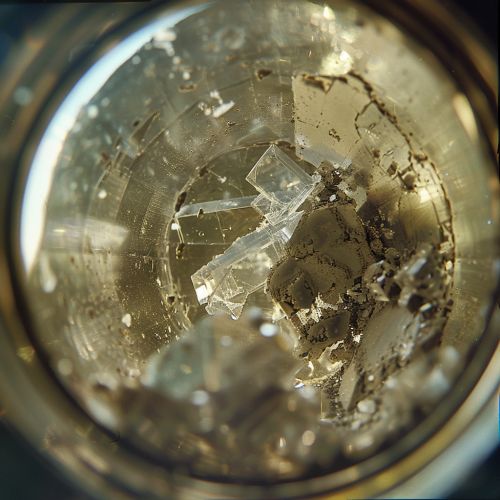Potassium-40: Difference between revisions
(Created page with "== Introduction == Potassium-40 (40K) is a radioactive isotope of potassium which has a long half-life of 1.251×10^9 years. It makes up 0.012% of the total amount of potassium found in nature. Potassium-40 is a rare example of an isotope that undergoes all three types of beta decay. About 89.28% of the time, it decays to calcium-40 (40Ca) with emission of a beta particle (β), with a maximum energy of 1...") |
No edit summary |
||
| (One intermediate revision by the same user not shown) | |||
| Line 26: | Line 26: | ||
[[Category:Radiometric dating]] | [[Category:Radiometric dating]] | ||
[[Image:Detail-77737.jpg|thumb|center|A close-up view of a sample of Potassium-40. The sample should be in a safe containment, with a clear view of its physical state.|class=only_on_mobile]] | |||
[[Image:Detail-77738.jpg|thumb|center|A close-up view of a sample of Potassium-40. The sample should be in a safe containment, with a clear view of its physical state.|class=only_on_desktop]] | |||
Latest revision as of 12:45, 7 May 2024
Introduction
Potassium-40 (40K) is a radioactive isotope of potassium which has a long half-life of 1.251×10^9 years. It makes up 0.012% of the total amount of potassium found in nature. Potassium-40 is a rare example of an isotope that undergoes all three types of beta decay. About 89.28% of the time, it decays to calcium-40 (40Ca) with emission of a beta particle (β), with a maximum energy of 1.33 MeV and an antineutrino. About 10.72% of the time it decays to argon-40 (40Ar) by electron capture, with the emission of a 1.460 MeV gamma ray and a neutrino. Very rarely (0.001% of the time) it will decay to 40Ar by emitting a positron (β+) and a neutrino.
Physical Properties
Potassium-40 is a unique isotope that presents three modes of radioactive decay. In addition to beta decay, it can also undergo positron emission and electron capture. These decay modes are influenced by the atomic and nuclear structure of the isotope, and studying these can provide valuable insights into the forces at work within the atom.
Biological Role
Potassium-40 is the largest source of natural radioactivity in animals and humans. Despite its radioactivity, this isotope is an essential and beneficial part of the natural environment. It is a key contributor to the small amount of radiation, termed background radiation, which is constantly absorbed by all living beings. It is also the most common radioisotope in the human body, contributing to the majority of the natural radioactivity within us.
Geological Significance
Potassium-40 plays a crucial role in radiometric dating methods, such as potassium-argon (K-Ar) dating and argon-argon (Ar-Ar) dating. These methods are used to determine the age of rocks and fossils. This isotope also contributes to the heat of the Earth's mantle and crust, and is thus integral to the study of geology and geothermal energy.
Cosmological Role
In the field of cosmology, the abundance of Potassium-40 serves as a tool to understand the formation and evolution of the Earth and other celestial bodies. The presence of this isotope in meteorites provides evidence for the age of the Solar System and allows scientists to study the processes that led to the formation of planets.
See Also
- Isotopes of potassium
- Radioactive decay
- Beta particle
- Positron
- Potassium–argon dating
- Argon–argon dating


